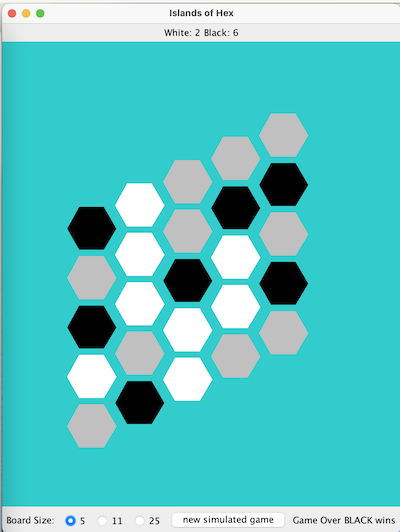
In this assignment you'll construct the backend for a game played on a grid style board - the grid is composed of hexagon shaped tiles. The game is simple it's a two player game with one player playing white game pieces and the other playing black game pieces. The goal for the game is to have the most islands on the game board when the game finishes. The game ends when either black bisects the board with a continuous chain of game pieces from left to right or white bisects the board with a continuous chain of game pieces from top to bottom.

An island is a connected group of similarly colored game pieces that are surrounded by either empty tiles or tiles occupied by the opposite color. Connections are determined by hexagons that share a border.
In the below example there are 2 white islands and 6 black islands (the gray squares are empty). In this case the white tiles have formed a path from the top of the board to the bottom and therefore the game is over. Since the game is over the black player has won the game 6-2 (note that ties are possible in this version of the gamse).

Your job is to write the backend for this game. You will be responsible for the following functionality:
You are given a front-end graphical user interface that allows you to visualize the game. Your back-end code should work with this front-end but also pass a number of provided unit-tests.
The front-end and unit-tests are dependent on you completing the methods inside the islands.backend.GameModel.java class. In completing that class you may also want to add additional classes and methods (and are encouraged to do so).
See below the GameModel class that you must complete:
package islands.backend;
/**
* Class to model the play of the game
*
*/
public class GameModel {
public static final int EMPTY = 0;
public static final int WHITE = -1;
public static final int BLACK = 1;
/**
* Construct a game with given sizexsize and an empty game board
* @param sz the square size of the board
*/
public GameModel(int sz) {
}
/**
* Can a play be made at position row, col
* @param row the row in question
* @param col the col in question
* @return true if row, col is empty, false o.w.
* @throws IllegalArgumentException for invalid row and col
*/
public boolean canPlay(int row, int col) {
return true;
}
/**
* play a piece and report if the game is over (true) false, otherwise
* @param row the row where a piece is played
* @param col the col where a piece is played
* @param clr true for WHITE and false for BLACK
* @return true if the game is over and false otherwise
* @throws IllegalArgumentException for invalid row and col
*/
public boolean makePlay(int row, int col, int clr) {
return false;
}
/**
* Return the score for white
* @return white score
*/
public int whiteScore() {
return 0;
}
/**
* return the score for black
* @return black score
*/
public int blackScore() {
return 0;
}
}
There are 3 different game play scenarios
(although the unit-tests also include a larger game board possibility to test your algorithm choice)
The game may be played with two players, or a game may be simulated with (non-intelligent) random computer players against each other.
There is an extensive set of unit-tests to ensure your solution is both accurate and efficient.
Deliverables:
There are two deliverables associated with this assignment.
You must check in code that passes the FirstDeliverable unit-tests
You can run the FirstDeliverableTests with the following gradle command:
gradle test --tests *FirstDeliverableTests
Note that the first deliverable is associated with the canPlay method. There is no scoring nor determining if that game is over or not. You can mostly achieve the first deliverable by creating a model to track where game pieces are played and reporting if a hex tile is already in use or not.
Grading to be completed by Github Autograding. Each time you push code to your repository the testcases will be run. Your code must be passing the basic tests by the above due date to receive full marks for part 1.
Grading: x/2pt
Your completed assignment should be checked into the repository.
Grading:
A grading rubric based on the following is distributed with the assignment:Functionality
Code Readability
Code design
Efficiency